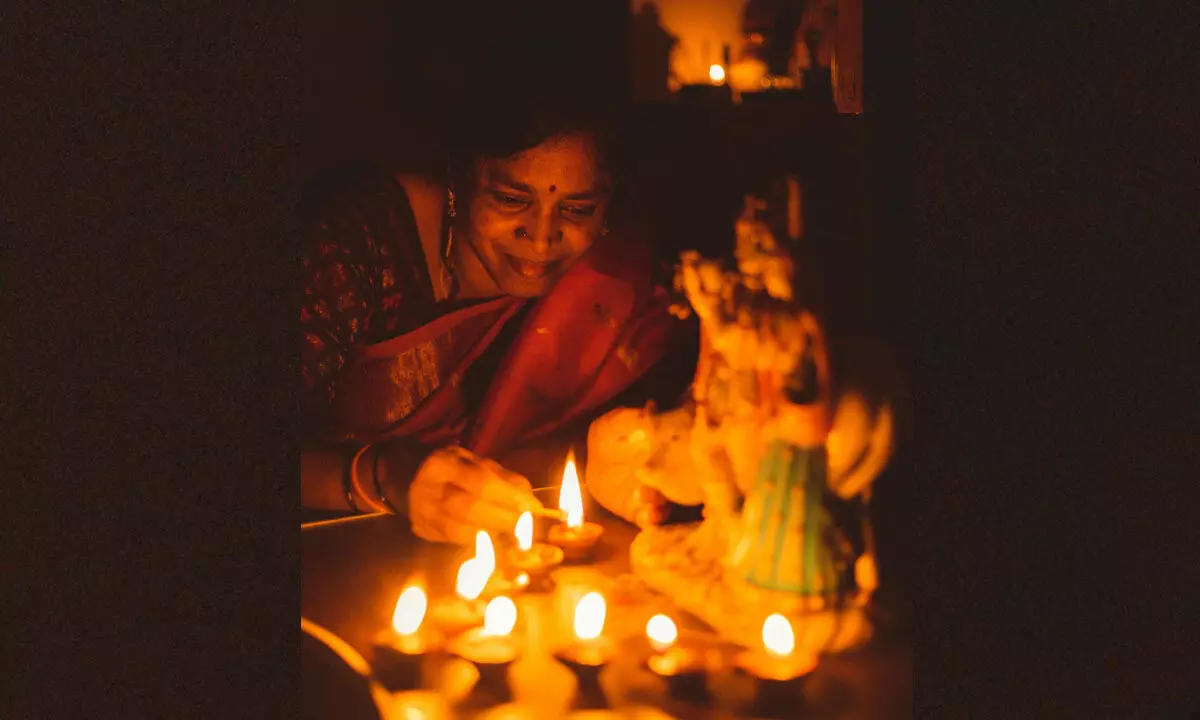Live
- Mass Rally Organized by BJP in Hyderabad on Atal Bihari Vajpayee's Centenary Celebration
- J&K: With over 25,000 houses built under PMAY, Doda ranks second in Jammu region
- Celta Vigo extend all-time club top-scorer Iago Aspas’ contract till 2026
- BGT: Kaif gives preference to Jaiswal-Rahul opening pair for Boxing Day Test against Australia
- Odisha CM Majhi, Naveen Patnaik extend Christmas greetings
- Icebreaker Keyboard: AluminIum Design Costing as Much as a MacBook Pro
- ‘Rifle Club’ Movie Review: A Stylish Thriller That Falls Short in Storytelling
- Chennai to Experience Heavy Rain as Severe Low-Pressure System Approaches Coastal Areas
- Pradeep’s ‘Akkada Ammayi Ikkada Abbayi’ hypes up with energetic new song
- Dil Raju releases ‘Adi Dha Saaru’ song from ‘Sahakutumbanam’
Just In

We have the tradition of lighting lamps at the beginning of every puja
We have the tradition of lighting lamps at the beginning of every puja. It is one of the sixteen prescribed courtesies (upacharas) to be extended when we invoke any deity either in our house or in the temple. There are other courtesies such as a welcome gift, water to wash feet, bathing, offering the sacred thread and clothes, perfume, offering food and some others on this list of sixteen. However, lighting the lamp is the most visible thing in these formalities. In modern times this has transformed into a spectacular event with the aid of modern technology in several places. Ayodhya witnessed millions of lamps lit by millions of devotees. The holy rivers Ganga and others have their aarati programs every evening and so are special occasions during the present month of Kartika.
It is well known that the lamp is a symbol of knowledge. It is a symbol which has been in use since ancient times. When it enlightens and illuminates, it is compared to a lamp. When it destroys some wrong perception, it is compared to fire, jnana-agni. It is the aspect of fire, emanating from the third eye, the eye of knowledge, which destroys the fleeting but improper amorous thought which arose in the mind of Shiva when he looked at Parvati. It is described as the destruction of Kama, symbolically.
The Gita refers both to fire which destroys ignorance, and to the light, the jnana-dipa (10-11), which leads to liberation. The commentator Shankaracharya describes the ingredients of this lamp vividly. In a traditional lamp oil has to be poured into an empty earthen or metallic vessel and a wick soaked in oil has to be kept in it. Our mind which has attained dispassion from worldly desires is the receptacle. This has to be filled with oil, which is the combination of bhakti (devotion), purity and love. The wick is the spiritual sadhana and austerities which the person has observed over a period. This wick would shine bright when fanned by the gentle breeze, which is the mind immersed in the thought of God, without getting disturbed by any extraneous thought or desire. The lamp is in the windless recesses of the mind, detached from sense objects. Such withdrawal is the curtain which protects the lamp from external distractions. The darkness called ignorance is removed and self-knowledge shines.
Normally, the role of a guru is spoken of in the context of self-knowledge, because mere bhakti would not lead to liberation without self-knowledge. Hence, Krishna says that God’s grace will ensure that the devotee of the type mentioned above will attain such knowledge. The devotee gets endowed with buddhi-yoga.
There is also a term named akasa-deepam, the sky lamp. People try to choose the highest place such as the roof top and put lamps during this month. Etymologically, akasa is that which shines everywhere, even in a room. A student of Vedanta would interpret it as the light of knowledge in one’s own chit-akasa, the mind space in which the light of knowledge has to be lit.
But all this serious symbolism is not everybody’s cup. People need festivity, ceremony and pomp to be blended with bhakti. Sometimes the grand gala shows such as the festival of ten million lamps, organized in Hyderabad draw a huge response. It is a great occasion in which the whole family witnesses the spectacle besides listening to the wise sayings from pundits. However, the role of women in implementing dharma within the house is important. After elaborately drafting the code for day-to-day life, Apastamba, the famous sage, ends it with the advice that whatever is forgotten or not mentioned therein, could be known from the elderly women in the family. Many other texts, too, praise the role of women as the custodians of Dharma, because they are our primary teachers who instill religious discipline in us.
(The writer is a former
DGP, Andhra Pradesh)

© 2024 Hyderabad Media House Limited/The Hans India. All rights reserved. Powered by hocalwire.com







